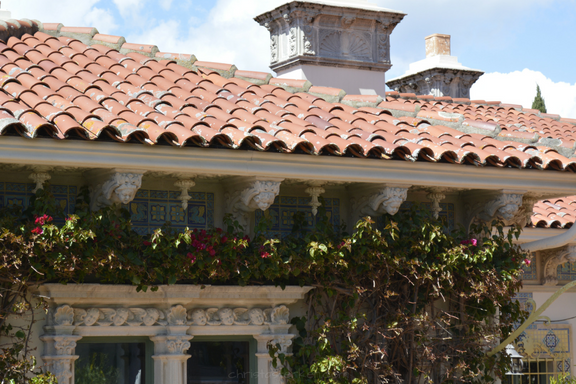Historic Landmark Spotlight: Clay Tile Roof at Hearst Castle, San Simeon, CA
Historical Clay Roof
I had the chance to visit Hearst Castle years ago, and it left a lasting impression on me. The estate itself is breathtaking, but what stood out most—beyond the sweeping coastal views and lavish interiors—was the incredible architectural detail throughout the property. From the intricate ceilings to the grand staircases, every element was thoughtfully crafted.
One feature that truly captured my attention was the clay tile roofing. The warm terracotta tones, paired with the structure's Spanish and Mediterranean influences, gave the entire estate a timeless and elegant feel. The way the tiles crown the various villas and towers feels both regal and rooted in tradition. It’s the kind of roof that not only protects but also tells a story—one of craftsmanship, history, and enduring beauty.
Location & Significance
Perched on the coastal hills above San Simeon, California, Hearst Castle (built 1919–1947, designed by Julia Morgan) stands as one of America’s most iconic historic estates. Now a National Historic Landmark and California State Park, its ceramic clay tile roofs exemplify Spanish Colonial and Mediterranean Revival architecture dci-engineers.com.
Tile Style, Color & Manufacturer
Tile Style: Classic barrel/mission-style ceramic clay tiles.
Color: Warm, aged terracotta tones—soft reds and oranges that have weathered gracefully over decades.
Manufacturer: Original tiles largely date to period manufacturers of the early 20th century; missing or damaged tiles were custom-replicated during restoration by kiln artisans using clay formulations to match the originals mca-tile.com.
Historic Preservation & Reroof Restoration
In 2016–2020, Hearst Castle underwent its first complete reroofing for its main “Casa Grande” and guesthouses:
80% of original tiles were salvaged and reinstalled to retain the castle’s historic fabric christasterken.comroofingcontractor.com+2dci-engineers.com+2dci-engineers.com+2.
Unsalvageable tiles were replaced in kind with custom replicas matched in shape, size, texture, and color spokesman.com+5dci-engineers.com+5ceqanet.opr.ca.gov+5.
A new waterproofing membrane and anchoring system was installed beneath the tiles for improved weather protection and seismic safety .
Restoration was coordinated with wildlife biologists to protect lichen and bat habitats under the roofing ceqanet.opr.ca.gov+4dci-engineers.com+4dci-engineers.com+4.
All work complied with the Secretary of the Interior's Standards for Historic Properties en.wikipedia.org+13ceqanet.opr.ca.gov+13dci-engineers.com+13.
Why Hearst Castle Matters
It’s a prime example of early-20th-century ceramic clay tile roofing on a grand scale.
Demonstrates how authentic materials and handcrafted replacements maintain historical integrity.
Reflects how sensitive reroofing can respect both natural and cultural heritage through thoughtful design and planning.
Final Take
Hearst Castle’s roof restoration combines traditional clay craftsmanship with modern preservation techniques, ensuring its terracotta crowning glory remains as breathtaking and resilient as it was nearly a century ago. For historical and architectural roofing enthusiasts, its story is a powerful lesson in heritage stewardship and quality materials.

